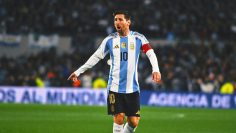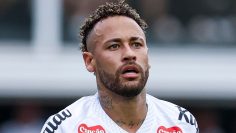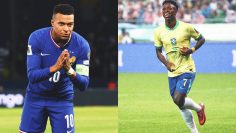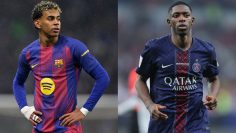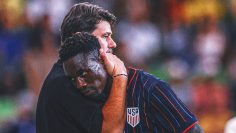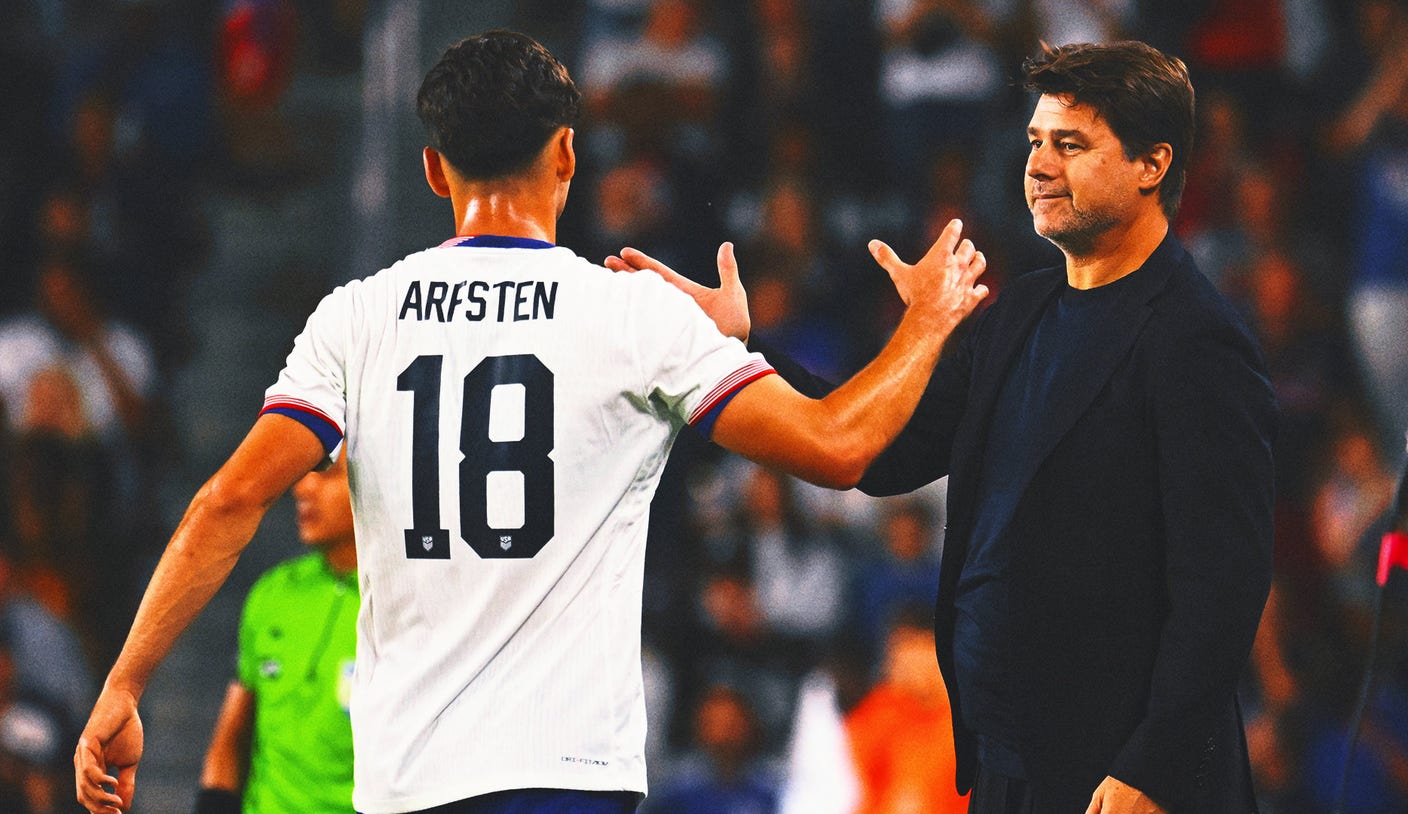
Nine Months Until the World Cup. What Were the USMNT’s September Lessons?
More than a year before Mauricio Pochettino was appointed the U.S. men’s national team coach, his name was brought up in a passing conversation.
I asked former U.S. goalkeeper Brad Friedel if he felt the team would be better served by a non-American manager for the 2026 World Cup cycle. Friedel, who played under Pochettino at Tottenham, used his former boss to explain why a foreigner might struggle.
[WORLD CUP 2026: WHICH TEAMS HAVE QUALIFIED?]
“He and his staff would want a year just to assess everything and learn as much as possible,” said Friedel, who still owns the Premier League record for consecutive appearances.
Fast-forward then to October 2024. When Pochettino was actually hired for his first ever national team job, he knew the timeframe would be abbreviated.
“The normal way to work is four years to implement your ideas and your philosophy, create your staff,” Pochettino said last week about the typical national team coaching cycle.
Mauricio Pochettino when he was hired in September 2024. (Photo by Luke Hales/USSF/Getty Images for USSF)
He’ll have had less than two years once the World Cup starts next June 12.
Plenty has already happened in the 12 months since Pochettino was brought in to steer the co-hosts to a successful tournament. This month against two fellow World Cup-bound squads, the U.S. just played its worst game under Pochettino (a 2-0 loss to South Korea on Sept. 6), followed by its best (a 2-0 win over Japan on Sept. 9).
In these two matches, we probably learned more about Pochettino’s USMNT than during the rest of his brief tenure combined.
Replacing a ‘father figure’
After the win over Japan, Pochettino reminded fans and media why he was hired to replace Gregg Berhalter last September.
“When we arrived, it’s because something was wrong,” Pochettino said of himself and his longtime backroom staff. “We listened to a lot of people talking, inside and outside of the [U.S. Soccer] federation, that something needs to change. ‘We need a new face, a new philosophy and new ideas and culture.’ You were talking here in the USA about this.”
In the spring of 2023, senior players like Pulisic and Tim Weah had gotten their wish when they successfully lobbied for 2022 World Cup coach Berhalter to return for a second cycle. Most of the American core had come of age under the former USMNT defender, who led the program back to the World Cup after the epic failure to qualify for the 2018 event, reaching the second round at Qatar 2022.
“Gregg was a father figure for a lot of these guys,” according to one team source.
The Gregg Berhalter era ended with group-stage exit at the Copa America. (Photo by Bill Barrett/ISI Photos/USSF/Getty Images for USSF)
A degree of rebellion was probably inevitable.
Things took just over a year to unravel. The first public sign of petulance came in the final match of 2023, when Sergiño Dest was shown two yellow cards for dissent in a decisive Concacaf Nations League quarterfinal in Trinidad. Despite the 2-1 loss, the USMNT advanced. In the semifinals in March 2024, the U.S. needed a 95th minute own goal to avoid an upset against Jamaica.
A dos-a-cero win over Mexico in the final papered over the cracks. But the roof caved in that summer.
As hosts of the 2024 Copa América, an undisciplined U.S. side stumbled on the pitch. An opening 2-0 win over Bolivia was soured by a shocking 2-1 loss to Panama, in which Weah was shown an early red card for striking a Panama player.
There was also disorder behind the scenes. Key veteran Weston McKennie arrived at the pre-Copa camp noticeably unfit, according to multiple sources. Berhalter still started him in all three group games (and the two friendlies beforehand), to the chagrin of teammates.
McKennie performed poorly. Berhalter seemed to have lost control. Ten days after the Americans were eliminated with a 1-0 defeat to Uruguay – the first time a Copa América host had ever been eliminated in group play – Berhalter had lost his job.
Pochettino went out of his way not to rock the boat when he was hired that September. His first roster for two friendlies against Panama and Mexico included 19 of the 26 players from the Copa América.
But he faced a challenge immediately. A banged-up Pulisic asked to return to AC Milan following Pochettino’s debut win in Austin rather than travel to Guadalajara, Mexico, for the midweek friendly against the Americans’ biggest rival. Pochettino obliged, releasing Pulisic and four others early, and reflexively covered for his star.
Christian Pulisic playing in Mauricio Pochettino’s first game as USMNT manager. (Photo by John Dorton/ISI Photos/USSF/Getty Images)
“We are a little bit worried about [Pulisic],” Pochettino said ahead of those games. “Sometimes we need to protect [him]. When we really need him, then he’ll need to be in form, happy, strong.”
Yet the USMNT’s subsequent 2-0 loss to Mexico in Guadalajara – which snapped a seven-game unbeaten streak against El Tri — was obviously not the first impression the new coach wanted to make on an expectant fan base.
Nonetheless, 2024 ended on a high when U.S. took both legs of a Nations League quarterfinal home-and-away with Jamaica, including just its second ever competitive win in Kingston.
‘A big wake-up call’
Pochettino relished the chance to get an extended look at the fringes of the American player pool during the USMNT’s January training camp, which consisted mostly of out-of-season MLS players.
And he liked what he saw, especially off the field: team-first underdogs desperate to represent their country and earn consideration for a World Cup staged on American soil. Some of these players – Patrick Agyemang, Diego Luna Max Arfsten, Jack McGlynn – have now become regulars.
Luna starred at the Gold Cup. Arfsten set up the game-winning goal on Tuesday against Japan while substitute. McGlynn rattled the crossbar during his solid showing.
But in March, Pochettino summoned his strongest on-paper team to Los Angeles for the Nations League semifinal with Panama.
With just two training sessions to prepare, the U.S. had to hit the ground running. It was Tyler Adams’ first camp under Pochettino, but the 2022 World Cup captain still felt it was his team. The Argentine quickly reminded Adams that his was a new regime.
“It was like, ‘you’re not my captain yet,’” according to one source. (Ream has worn the armband in 14 of the 18 games under Pochettino so far.)
A disappointing show at the Nations League semifinals was a wake-up call. (Photo by Shaun Clark/ISI Photos/USSF/Getty Images for USSF)
The U.S. lost on a late Canaleros goal, snapping their streak of three straight Nations League titles. Canada then beat Pochettino’s squad in the third-place match. With 20 minutes remaining and the Americans trailing, Pochettino removed Adams, Pulisic and McKennie — widely considered his three most important players.
While he struck a conciliatory tone in his postgame press conference, even apologizing for the loss to Canada. Pochettino was privately what one source described as “furious” with his team.
“It was a big wake-up call,” Pochettino said last week about that March window, noting that the team lost despite the presence of its biggest names.
“We need to call the players that can perform,” he said. “All that happened [in March] helped a little bit to realize that the most important thing is the national team.
“This,” he added, pointing to the USA crest on his track top, “is more important than any single name.”
‘Stick with our plan’
If Pochettino wanted to use this past summer’s Gold Cup to send a message that the Nations League showing was unacceptable, FIFA Club World Cup complicated that plan.
McKennie and Weah wouldn’t be available for the regional championship anyway because their club, Juventus, was competing in FIFA’s revamped 32-team event, which was played at the same time as the Gold Cup.
Same for Gio Reyna, who some speculated could be released for international duty with his days coming to an end at the German club Borussia Dortmund. (U.S. Soccer never even asked Dortmund, sources said.)
Still, Pochettino’s remarks upon naming the Gold Cup squad were pointed.
“If you arrive to the camp and you want to spend a nice time, play golf, go for a dinner, visit my family, visit my friend … that is the culture that we want to create?” Pochettino back in May. “No, no, no, no, no.”
The Gold Cup squad under Pochettino was comprised mostly of MLS-based players. (Photo by Aric Becker/ISI Photos/USSF/Getty Images)
Pochettino also warned: “If we want to be good in one year’s time [for the 2026 World Cup, we need to think that today is the most important day.”
Pochettino wanted Adams, Richards and especially Pulisic for the Gold Cup. So he was blindsided when a U.S. Soccer official informed him that Pulisic wanted to skip the USMNT’s last competitive tournament before the all-important main event in 2026.
It probably didn’t help that the call came from Pulisic’s agent and was delivered through an intermediary. Pulisic eventually explained his position on a CBS podcast, an attempt at damage control that backfired when he said he “didn’t understand” why Pochettino wanted him for the whole summer, and not just two pre-Gold Cup tuneups against Turkyie and Switzerland.
Pochettino didn’t cover for Pulisic this time.
“Players need to listen and to stick with our plan. They cannot dictate the plan,” Pochettino said. “I am the head coach. I am not a mannequin.”
Three other starters from the Nations League semifinal — Tanner Tessmann, Josh Sargent and Joe Scally — didn’t crack the 26-player Gold Cup list despite being healthy and available.
In their places were uncapped MLS players including Sebastian Berhalter, the former coach’s 24-year-old son; Orlando City fullback Alex Freeman, son of Super Bowl-winning wide receiver Antonio Freeman; and NYCFC goalkeeper Matt Freese, a Harvard graduate.
Without most of its European-based stars, the U.S. reached the final against Mexico, taking the lead in front of 71,000 mostly El Tri fans in Houston before succumbing 2-1.
“From October [2024], when we got here, we were always talking about ‘come on guys, we need to be a team,” an emotional Pochettino told his players in the locker room.
“I feel so proud. You did everything. And I hope we can keep this feeling, to work together and work for the team.”
‘The process is going to work’
For the most recent games, Pochettino’s roster choices seemingly encapsulated what he experienced during his short time as USMNT manager.
Pulisic was back, as were other 2022 World Cup starters Josh Sargent and Sergiño Dest. But Pochettino brought in 12 players from the Gold Cup squad while leaving out McKennie, Musah, Cardoso, Tessmann and longtime No. 1 keeper Matt Turner. Instead of European-based center back Mark McKenzie and Cameron Carter-Vickers, who struggled mightily when paired against Canada in March, 29-year-old MLS veteran Tristan Blackmon was called up for the first time.
The reliance on MLS players came under scrutiny after South Korea played the U.S. off the field. Pochettino pushed back, and even invoked the 2002 U.S. World Cup squad, which had an almost even split between those based at home and overseas.
“I don’t know how after came the idea of, if you play in the MLS, you cannot be in the national team,” Pochettino said before the Japan game.
Blackmon and five other starters kept their spots as the Americans rebounded against Japan. Unlike the first game, the U.S. was intense, organized, sharp, and decisive. They created genuine high-end scoring opportunities instead of the slow-percentage half-chances they mustered mostly in the second half against the Koreans.
A win over Japan showed some promising signs and adjustments for Mauricio Pochettino. (Photo by Koji Watanabe/Getty Images)
Defensively, Pochettino’s switch to a three-centerback system was a masterstroke, with the hosts keeping a clean sheet (thanks in part to Freese’s six saves) for the first time in six tries.
That doesn’t mean Christian Roldan will make the 2026 roster over McKennie, or that Freese has gone from uncapped Gold Cup long-shot to permanently supplanting Turner as the No. 1 keeper. But there’s now legitimate competition for starting spots where for far too long there wasn’t.
“The most important thing is the process,” Pochettino said. “It’s about the players really believing in what we are doing, how they respect us, how we respect them.”
It’s something that Pochettino has created out of necessity, and almost out of thin air.
“We are going to have the best players [at the World Cup] and the players that maybe are not here today will have the possibility to come [back].
“It’s about giving time to the process, and the process is going to work for sure. I don’t have any doubt.”
Doug McIntyre is a soccer reporter for FOX Sports who has covered United States men’s and women’s national teams at FIFA World Cups on five continents. Follow him @ByDougMcIntyre.
What did you think of this story?
recommended
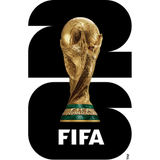
Get more from the FIFA Men’s World Cup Follow your favorites to get information about games, news and more






